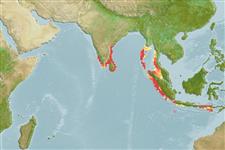Environment: milieu / climate zone / depth range / distribution range
Sinh thái học
Biển Cùng sống ở rạn san hô; Mức độ sâu 1 - 125 m (Ref. 89707), usually 1 - 12 m (Ref. 90102). Tropical; 16°N - 11°S, 75°E - 121°E (Ref. 5222)
Eastern Indian Ocean: southern India, Sri Lanka, and southern Indonesia. However, it is likely that its distribution is continuous from Pakistan to Indonesia. Record from the Chagos Archipelago is based on Epinephelus macrospilos (Ref. 6495).
Bộ gần gũi / Khối lượng (Trọng lượng) / Age
Maturity: Lm ? range ? - ? cm
Max length : 32.0 cm TL con đực/không giới tính; (Ref. 5222)
Các tia vây lưng cứng (tổng cộng): 11; Các vây lưng mềm (tổng cộng): 16-18; Tia cứng vây hậu môn 3; Tia mềm vây hậu môn: 8. Distinguished by having whitish or pale grey color; head, body and fins with numerous close-set round brown spots of unequal sizes; cycloid scales except region under pectoral fins; body with numerous auxiliary scales; greatest depth of body 3.0-3.5 in SL; rounded caudal fin; pelvic fins, 2.2-2.7 in head length (Ref. 90102); further characterized by flat or slightly concave interorbital area, convex dorsal head profile; rounded preopercle, with shallow indentation just above angle and slightly enlarged serrae at the angle; upper edge of operculum slightly convex; subequal posterior and anterior nostrils; maxilla reaches past vertical at rear edge of eye; 2 rows of teeth on midlateral part of lower jaw (Ref. 89707).
Occurs in shallow waters over coral reefs or rocky substrate. It appears to be a small species; a 17 cm SL fish from Sri Lanka has fairly well-developed ovaries. Solitary (Ref 90102).
Life cycle and mating behavior
Chín muồi sinh dục | Sự tái sinh sản | Đẻ trứng | Các trứng | Sự sinh sản | Ấu trùng
Heemstra, P.C. and J.E. Randall, 1993. FAO Species Catalogue. Vol. 16. Groupers of the world (family Serranidae, subfamily Epinephelinae). An annotated and illustrated catalogue of the grouper, rockcod, hind, coral grouper and lyretail species known to date. Rome: FAO. FAO Fish. Synop. 125(16):382 p. (Ref. 5222)
IUCN Red List Status (Ref. 130435)
Threat to humans
Harmless
Human uses
Các nghề cá: Tính thương mại
Thêm thông tin
Các tài liệu tham khảoNuôi trồng thủy sảnTổng quan nuôi trồng thủy sảnCác giốngDi truyềnElectrophoresesDi sảnCác bệnhChế biếnNutrientsMass conversion
Các công cụ
Special reports
Download XML
Các nguồn internet
Estimates based on models
Preferred temperature (Ref.
123201): 28.1 - 29.4, mean 28.6 °C (based on 216 cells).
Phylogenetic diversity index (Ref.
82804): PD
50 = 0.5000 [Uniqueness, from 0.5 = low to 2.0 = high].
Bayesian length-weight: a=0.01175 (0.00571 - 0.02419), b=3.04 (2.88 - 3.20), in cm total length, based on LWR estimates for this Genus-body shape (Ref.
93245).
Mức dinh dưỡng (Ref.
69278): 3.7 ±0.5 se; based on size and trophs of closest relatives
Thích nghi nhanh (Ref.
120179): Trung bình, thời gian nhân đôi của chủng quần tối thiểu là 1.4 - 4.4 năm (Preliminary K or Fecundity.).
Fishing Vulnerability (Ref.
59153): Low vulnerability (22 of 100).
